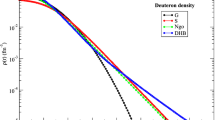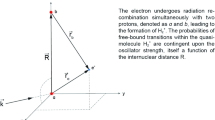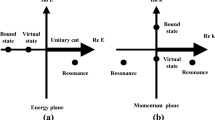Abstract
Transition amplitudes and transition probabilities for the two-photon 1s–2s transition in the hydrogen atom and 11 s–21 s transition in helium atom have been calculated using a partial-closure approach. The dominant term is calculated exactly and the remaining sum over intermediate states is calculated using a mean excitation energy. Our value of the transition amplitudes agree within 2% with the exact results for the hydrogen case. Our value of the transition probability for hydrogen is 8.50 s−1 which is in good accord with its known value 8.226 s−1. For helium, the photon energy distribution of the metastable 21 s state is in good agreement with the accurate values. The corresponding transition probability is 53.7 s−1 which is in good agreement with the accurate value 51.3 s−1.
Similar content being viewed by others
References
L Cook, D Olsgard, M Havey and A Sieradzan, Phys. Rev. A47, 340 (1993)
R P Meyer, M D Havey and A Beger, XIV ICAP, Abstracts of contributed papers (Boulder, CO, 1994) p. 2A-3
P C Stancil and G E Copeland, J. Phys. B27, 2801 (1994)
H Walter, Laser spectroscopy edited by H Walter (Springer, Berlin, 1976)
T W Hansch, S A Lee, R Wallenstein and C Wieman, Phys. Rev. Lett. 34, 307 (1975)
S A Lee, R Wallenstein and T W Hansch, Phys. Rev. A35, 1262 (1980)
A Quattropani, F Bassani and S Carillo, Phys. Rev. A25, 3079 (1982)
F Bassani, A Quattropani and J J Forney, Phys. Rev. Lett. 39, 1070 (1977)
R J Drachman, A K Bhatia and A A Shabazz, Phys. Rev. A42, 6333 (1990)
R B Thayyullathil and K J Prasanna, Phys. Rev. A49, 2432 (1994)
A Dalgarno and J T Lewis, Proc. R. Soc. London A223, 70 (1955)
C J Artura, N Tolk and R Novick, Astrophys. J. 157, L181 (1969)
A J Duncan, Z A Sheikh, H Kleinpoppen and E Merzbacher, Selected topics in electron physics edited by D M Campbell and H Kleinpoppen (New York, Plenum, 1996) pp. 457–70
A J Duncan, Z A Sheikh and H Kleinpoppen, J. Phys. B30, 1347 (1997)
A Dalgarno, Mon. Not. R. Astron. Soc. 131, 311 (1966)
A Dalgarno and G A Victor, Proc. Phys. Soc. (London) 87, 371 (1966)
G A Victor, Proc. Phys. Soc. (London) 91, 825 (1967)
C W F Drake, G A Victor and A Dalgarno, Phys. Rev. 180, 25 (1969)
J Shapiro and G Breit, Phys. Rev. 113, 179 (1959)
B H Bransden and C J Joachain, Physics of atoms and molecules (Longman Inc., New York, 1983)
V Chandrasekharan and B Silvi, J. Phys. B14, 4327 (1981)
Author information
Authors and Affiliations
Rights and permissions
About this article
Cite this article
Bassi, M., Baluja, K.L. Transition probabilities for two-photon H(1s–2s) and He(11 s–21 s) transitions: A partial-closure approach. Pramana - J Phys 54, 377–384 (2000). https://doi.org/10.1007/s12043-000-0129-7
Received:
Revised:
Issue Date:
DOI: https://doi.org/10.1007/s12043-000-0129-7




